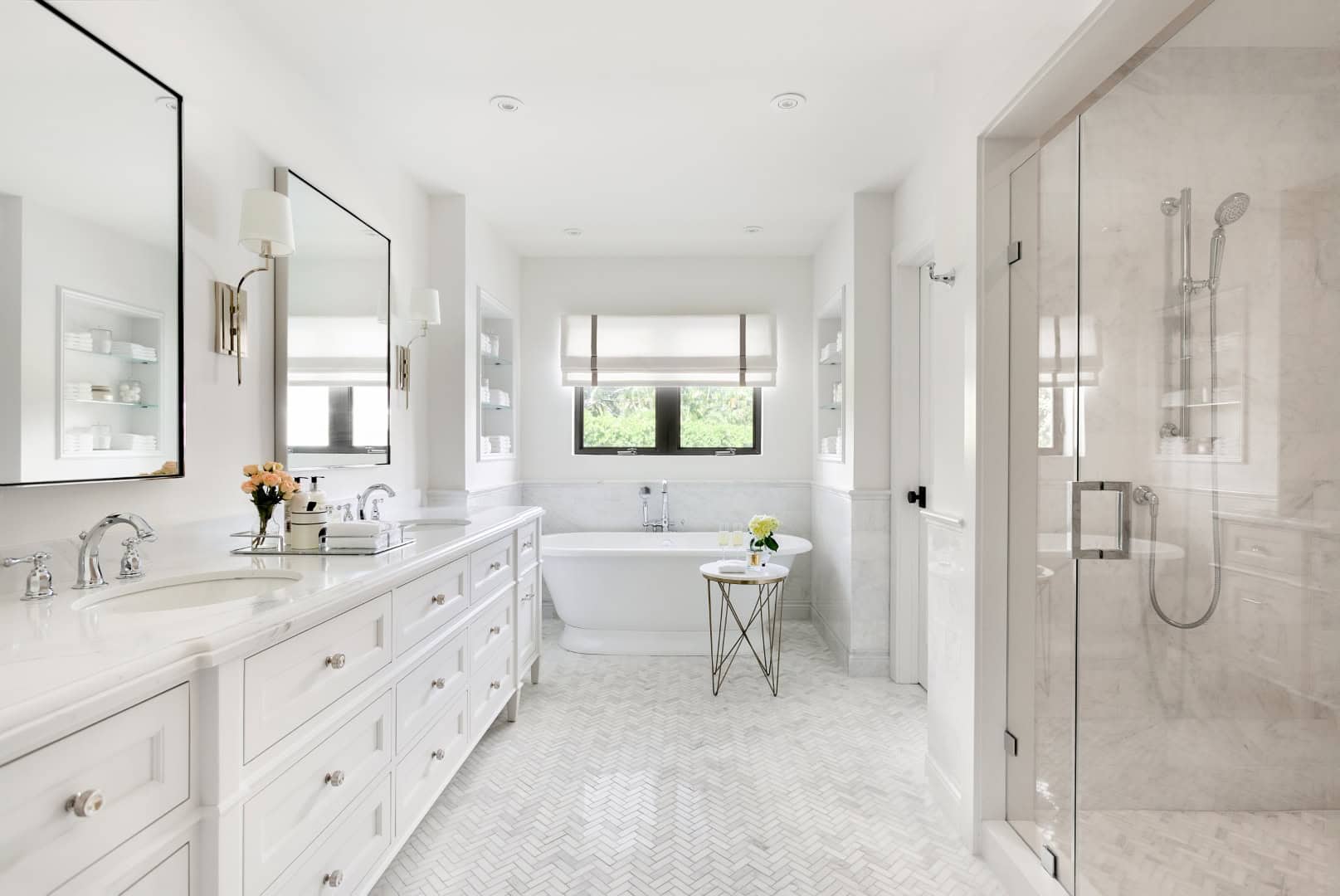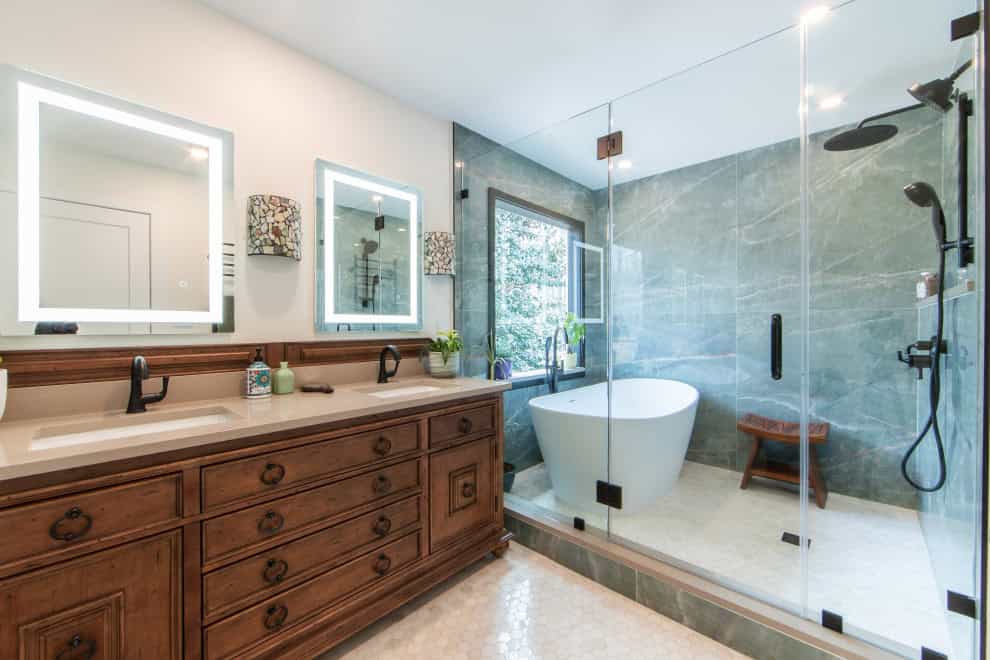The Fusion of Styles

The marriage of modern bathroom elements with a traditional house is like pairing a trendy new outfit with your favorite vintage jacket: it’s a clash of styles that somehow works, creating a unique and interesting look. While modern design prioritizes clean lines, minimalism, and functionality, traditional design embraces intricate details, ornate fixtures, and a sense of history. But, instead of clashing, these two aesthetics can actually complement each other beautifully, resulting in a bathroom that is both stylish and comfortable.
Incorporating Modern Elements into a Traditional Setting
Modern bathroom fixtures can seamlessly integrate into a traditional house, adding a touch of contemporary flair without compromising the original character. The key is to choose modern elements that complement the existing architectural features, rather than overpower them. For example, sleek, minimalist vanities can be paired with traditional crown molding or wainscoting, creating a balanced and visually appealing contrast. Similarly, geometric tiles can be used as accents, adding a modern touch to a traditional bathroom floor or shower.
- Sleek Faucets: A modern faucet with clean lines can add a touch of sophistication to a traditional bathroom. Look for faucets with minimalist designs and brushed nickel or chrome finishes. To avoid a jarring contrast, select faucets that complement the existing hardware in the bathroom, such as door handles or cabinet pulls.
- Minimalist Vanities: A modern vanity with a simple, geometric design can provide a sleek counterpoint to the intricate details of a traditional bathroom. Choose a vanity with a smooth, flat surface and minimal ornamentation. To maintain the traditional feel, select a vanity with a wood finish or a natural stone countertop.
- Geometric Tiles: Geometric tiles, such as subway tiles or hexagonal tiles, can add a modern touch to a traditional bathroom floor or shower. Use these tiles as accents, incorporating them into a larger pattern of traditional tiles or using them to create a unique feature wall.
Examples of Modern Elements Complementing Traditional Features
Modern elements can enhance the beauty of traditional architectural features, creating a harmonious blend of styles.
- Crown Molding: Modern, minimalist vanities can be placed against a backdrop of traditional crown molding, highlighting the intricate detail of the molding and creating a striking visual contrast.
- Wainscoting: Geometric tiles used in a shower or bathtub area can be juxtaposed against traditional wainscoting, adding a touch of contemporary flair while maintaining the classic charm of the wainscoting.
- Exposed Beams: Sleek, modern lighting fixtures, such as pendant lights or track lighting, can be installed against a backdrop of exposed beams, adding a contemporary element to the traditional architecture.
Designing a Balanced Bathroom Layout
A well-designed bathroom layout can balance modern functionality with traditional charm, creating a space that is both stylish and comfortable. Here’s an example of a layout that incorporates both modern and traditional elements:
| Element | Placement | Description |
|---|---|---|
| Modern freestanding bathtub | Center of the bathroom | A sleek, minimalist bathtub with clean lines and a modern design. |
| Traditional vanity with marble countertop | Against a wall with crown molding | A vanity with intricate details and a classic design, featuring a marble countertop for a touch of elegance. |
| Geometric tiles | Shower floor and walls | Modern geometric tiles, such as subway tiles or hexagonal tiles, used as accents in the shower. |
| Traditional wainscoting | Lower half of the bathroom walls | Traditional wainscoting adds a touch of classic charm to the bathroom. |
| Modern pendant light | Above the bathtub | A sleek, minimalist pendant light provides a contemporary touch. |
Material Choices

In a modern bathroom designed for a traditional house, the key is to strike a balance between contemporary and classic elements. This includes carefully selecting materials that complement the existing architecture while introducing a touch of modern flair.
Natural Materials
Natural materials like stone, wood, and metal have been used in bathrooms for centuries, and they continue to be popular choices today. In traditional bathrooms, these materials are often used in a more rustic or ornate manner. For instance, you might see a stone bathtub with intricate carvings or a wooden vanity with detailed moldings. In modern bathrooms, these materials are often used in a more minimalist way. Think sleek stone tiles, a simple wooden countertop, or a brushed metal faucet.
Modern Materials
Modern materials like acrylic, glass, and stainless steel can also be incorporated into a traditional bathroom, but it’s important to do so thoughtfully. Acrylic bathtubs and showers are popular choices for modern bathrooms because they are sleek, durable, and easy to clean. Glass can be used for shower enclosures, vanity tops, and even walls. Stainless steel is often used for faucets, fixtures, and accessories.
Color Palettes
When choosing a color palette for a modern bathroom in a traditional house, it’s important to consider the existing color scheme of the house. If the house has a warm and inviting color palette, you might want to choose neutral colors for the bathroom, such as white, gray, or beige. You can then add pops of color with accessories, such as towels, rugs, and artwork.
Visual Representation
Here is a visual representation of a modern bathroom in a traditional house:
| Material | Location | Style |
|—|—|—|
| Stone | Floor, Shower Walls | Natural, Polished |
| Wood | Vanity, Shelves | Dark, Reclaimed |
| Metal | Faucets, Fixtures, Towel Bar | Brushed Nickel |
| Acrylic | Bathtub | Sleek, Modern |
| Glass | Shower Enclosure, Vanity Top | Clear, Minimalist |
| Stainless Steel | Accessories | Sleek, Modern |
Lighting and Decor: Modern Bathroom In Traditional House

The right lighting and decor can transform a traditional bathroom into a stylish and modern oasis. This section explores how to leverage lighting techniques and incorporate modern decorative elements to achieve a harmonious blend of old and new.
Modern Lighting Techniques
Lighting plays a crucial role in setting the mood and highlighting the modern features of your bathroom.
- Recessed lighting provides a clean and minimalist look, ideal for showcasing modern fixtures and tiles. It creates a sense of spaciousness and sophistication.
- Pendant lamps, particularly those with geometric or contemporary designs, can add a touch of elegance and visual interest. They can be hung over the vanity or bathtub to create a focal point.
- Natural light is a valuable asset in any bathroom. Maximizing natural light by using large windows or skylights enhances the feeling of spaciousness and brightness, further complementing the modern aesthetic.
Modern Bathroom Accessories and Decor
Incorporating modern bathroom accessories and decor can add a touch of contemporary flair to your traditional bathroom.
- Minimalist artwork, such as abstract prints or black and white photographs, adds a sophisticated touch and complements the clean lines of a modern bathroom.
- Geometric mirrors, with their clean lines and unique shapes, reflect light and create a sense of depth and dimension. They also add a touch of modern elegance to the space.
- Sculptural plants, such as succulents or cacti, bring a touch of nature and a modern vibe to the bathroom. They are low-maintenance and add a touch of green to the space.
Balancing Modern and Traditional Decor, Modern bathroom in traditional house
Creating a cohesive blend of modern and traditional decor requires a delicate balance. Here is a visual guide that illustrates specific decorative elements and their placement:
| Decorative Element | Placement | Modern/Traditional |
|---|---|---|
| Geometric mirror | Above the vanity | Modern |
| Recessed lighting | Throughout the bathroom | Modern |
| Pendant lamp | Over the bathtub | Modern |
| Minimalist artwork | Above the toilet | Modern |
| Traditional vanity | Center of the bathroom | Traditional |
| Ornate tile flooring | Throughout the bathroom | Traditional |
Key Design Principles for Modern Integration
To successfully integrate modern elements into a traditional bathroom, consider these key design principles:
- Simplicity: Embrace clean lines, minimal clutter, and a streamlined aesthetic. Choose furniture and fixtures with simple shapes and designs.
- Contrast: Use contrasting colors and textures to create visual interest and define different areas within the bathroom. For example, you could use a sleek, modern shower enclosure against a traditional wall tile.
- Focal Point: Create a focal point using a statement piece, such as a geometric mirror or a modern freestanding bathtub. This helps to draw the eye and add visual interest.
- Functionality: Ensure that all elements in the bathroom are functional and serve a purpose. This includes storage solutions, lighting, and fixtures.
Modern bathroom in traditional house – The modern bathroom, a stark contrast to the traditional house’s rustic charm, demands a careful balance of style and safety. The sleek, polished tiles, while visually appealing, can be slippery, especially when wet. This is where the practicality of anti-slip bathroom rugs comes in.
They provide a much-needed layer of security, blending seamlessly with the modern aesthetic, ensuring a comfortable and safe experience in the heart of the traditional home.
The modern bathroom, with its sleek lines and minimalist design, can often feel out of place in a traditional house. But even within the confines of a timeworn space, a touch of whimsy can be injected. A festive St. Patrick’s Day bathroom rug , with its vibrant green and shamrock motifs, can bring a burst of color and playful energy, a reminder that even the most traditional spaces can embrace a touch of the unexpected.